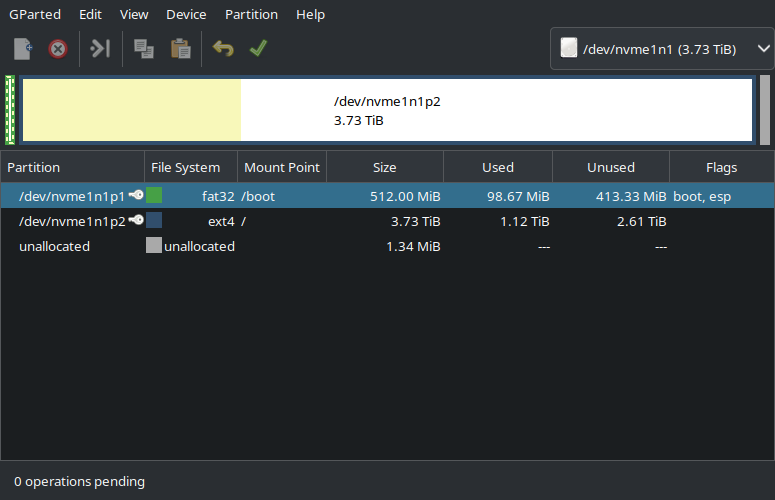How did you partition your disk before installing Linux? Do you regret how you set it up?
I’m looking for some real users experiences about this and I’m trying to find the best approach for my setup.
Thank you for sharing!
deleted by creator
I set up a dual boot over the winter, I’ve gone back to windows maybe 3 times at most.
I’ll still keep it around in case I ever decide to dabble in games that use rootkit anticheat (though since quitting destiny 2 I don’t see that happening lmao) and for other very occasional utility, but I’m definitely thinking of shrinking that partition even further
Defaults are usually fine for most users. People who know they are going to distro hop or need to move data later should have a separate
/home, but that’s about it until you get into special purpose installs.In 20 years of using Linux my partition scheme has always been to say yes to whatever the OS suggests.
It’s usually that way for a reason, is my thinking
I’ve been using Linux for over a quarter of a century. Initially I spent hours attempting to come up with the best partitioning scheme but these days I pick LVM and use the defaults.
If I run out of space, I add a drive (or grow the virtual one) and grow the filesystem into the extra space.
Sometimes I need temporary space and use sshfs to mount a directory from another machine.
In other words, today you have infinite options to adjust according to need, partition schemes are not nearly as important.
Even swap space can live as a file on a normal partition if required.
That said. If you have specific use cases, check what’s required. Specifically because different uses need different attributes, it pays to check.
~500 MB for /boot and the rest is LUKS-encrypted btrfs
I just chose the automatic partition thingy ¯\_(ツ)_/¯
Two separate EFI boot Partitions if you dual boot. Its not worth letting Windows know about linux. Linux chainloads to Windows boot.
For my desktop, I have two disks. One is root, one is home. They are single BTRFS filesystems with automated snapshots, compressions, and a few subvolumes. Works great.
For a laptop, similar but with only a single disk/partition and FDE. Also works well.

Just used the default for one big partition. I used to do tedious partition configurations, but it always ended up biting me down the road more than helping. This drive is for the OS, games, and working files. I have a 16TB NAS that holds anything worth saving, so if I need to nuke the whole thing and do a reinstall, all I really end up doing is downloading a bunch of Steam games again.
This gives basically no headaches at all. I am running this schema on all my Linux devices. And swap is done using a swapfile instead of a partition. This way, you can easily increase it later on.
I just use the automatic thingy on my distro so like:
- Esp: 2GB (Limine + btrfs snapshot booting)
- root: all the drive
save 80gb for root, sone swap (if not on an ssd) rest for /home. that way reinstalling or switching has minimal risk of losing my /home
I partitioned my disk 50/50 for Windows and Linux with some proprietary software. It didn’t end up working and i whiped my windows install.
Then I bought a new boot drive so my linux and macos install are physically separated.
Are you going to dual boot? Do you have some other special requirement? If not, there’s no reason to overthink partitioning in my opinion. I did this for my main NVME:
- Partition table: GPT
- /boot : 1GB fat32 partition. Depending on your needs (number of kernels, initramfs’s, other OSs) you might be fine with 500MB or even less. But because resizing can be a pain and I have the space to spare, I would much rather overprovision.
- / : LUKS2 partition containing a btrfs filesystem with all the remaining space
I use a swap file so I don’t use a swap partition. If you want more control over specific parts of the filesystem, eg a separate /home that you can snapshot or keep when reinstalling the system, then use btrfs subvolumes. This gives you a lot of the features a partition would give you without committing to a specific size.
This is the only partitioning scheme I have never regretted. When I’ve tried to do separate partitions I find myself always regretting the sizes I’ve allocated. On the other hand, I have not actually seen any benefit of the separation in practice.
not actually seen any benefit of the separation in practice.
The first time some big download hoses your root, you will be enlightened :-D
I have 1/3 of a 1 TB SSD for Windows, Linux and a free partition for random stuff each. With home finally on a second 2 TB SSD. This is great, so far.
main ssd with debian stable: a single partition for the system + swap
secondary harddrive: an opensuse, a debian testing, and a freebsd partition + shared data partition








